5 Best AI Content Detector Tools for Your Academic Papers + Essay AI Detection Guide
Mike Russel
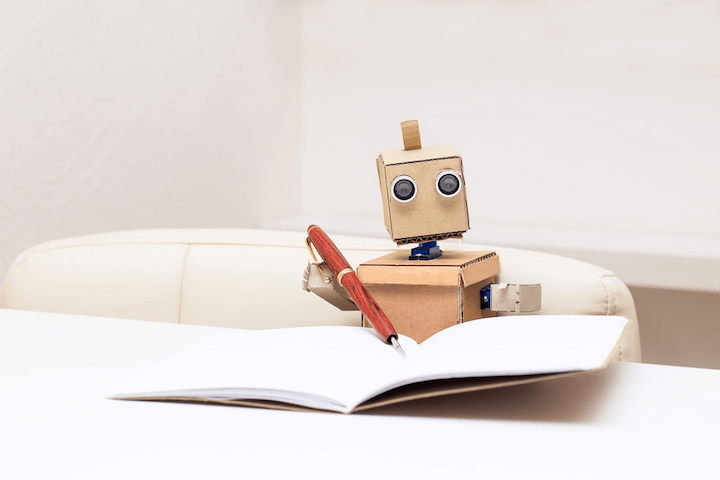
Many artificial intelligence technologies now help humans with various tasks. From blog posts to academic essays, a robot has the knowledge and surprising eloquence to deliver the most complex facts in a persuasive, serious, and engaging manner.
Students, in turn, have long waited for technologies like this to unload academic workload. But… academic institutions do not accept things like this, which is when AI detector programs come into play.
“Is this written by AI?” is the brand-new scariest question a student can hear from their professor. That is why students need to find the top AI detector to ensure academic AI detection tools do not create additional problems with evaluation. And that is what we are focusing on today.
AI Writing Detector Definition
Any AI content detector is a language model similar to a program that can generate texts, images, and other pieces. Today, most tools that let you check AI-generated content are experimental and still have code holes that prevent them from being 100% efficient. Nevertheless, those programs have a principle that lets them “decide” if a bot creates something.
How Do AI Writing Detectors Work?
In the simplest terms, an artificial intelligence detector “looks” at an input and “thinks” something like “Would I write this?” When the answer is positive, and the language model understands that this text is 1-100% similar to its style, it gives us a verdict: “This text is N% generated.”
In practice, that is a program that focuses on a piece’s
- Perplexity (as unpredictableness). A text is likelier to be AI-created when it is predictable, robotically logical, and has sentences with no character. Texts that demand more effort from readers are less likely to be written by a robot.
- And burstiness. Monotonous texts that make you read with a stable pace are less bursty than pieces with variable, contrasting, and unusual structures. Less bursty texts are considered to be AI’s style.
Perplexity checks
Regarding perplexity, compare the following options to finish a sentence that starts “Today is a great day because…”
| A sentence ending | Perplexity | Comment |
| … it’s Friday! | Low | 99% chance ChatGPT or another app wrote this text. |
| … I’ve finally finished work and can go play video games. | Medium | It may be an artificial creation, but this turn of words is more unexpected. |
| … I have finally avenged my nation, and my quest for vengeance will be complete soon after I slay the last god… | High | Dude, that’s wild No way, what is this Dark Souls fanfiction Not AI-generated!! |
But I must highlight that artificially created content can also be quite elaborate:
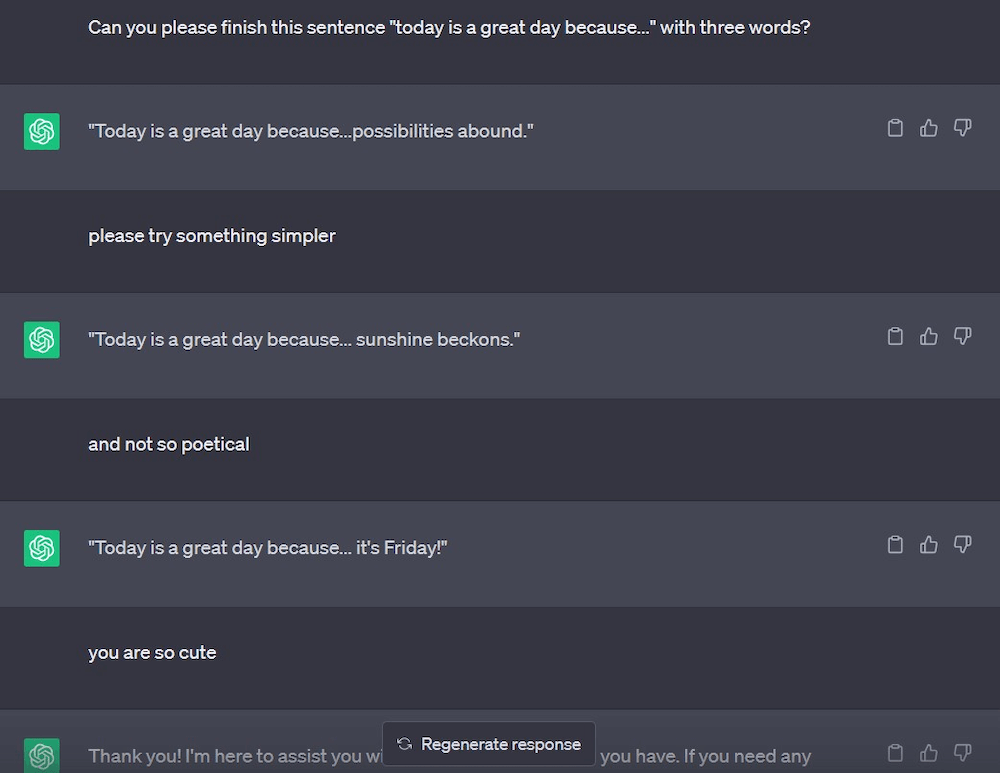
So, an AI-generated content checker will strive to evaluate how predictable, formularized, and unsurprising a text is. An unforeseen turn of events usually means something is a human’s creation.
What about burstiness?
Burstiness is more technical. An AI detector tool will look at sentences and how they are different. Even if those sentences by a bot are compound-complex, you will notice the monotonous tone, while a program will look at word order variability and focus on repetitious structures.
For example, here is how ChatGPT describes a flower:

A human (usually) will not be as consistent with sentence length, word choice, and emotional semi-tones. A human-written piece about a flower is likelier to be something like:
“Hyacinth, hyacinth… You are the page of spring with your small, tender blue flower bells. Wouldn’t your cold color be a perfect contrast to a sunny chrysanthemum? Or maybe your blue shades will contrast best with something lollipop pink? You can make a great bouquet alone! We must add a white, a pink, and a red one to…”
… you get the idea. The narrative’s pace is always more unstable when it is a person’s writing, while language models tend to stick to one pace for readability purposes.
Watermarks for a ChatGPT detector
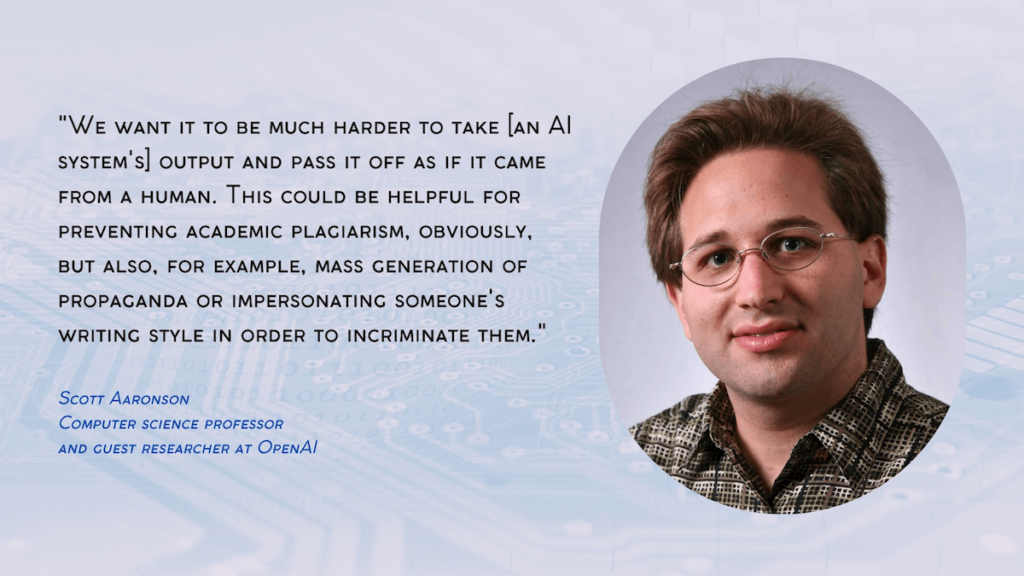
ChatGPT AI detection and similar tools for other content creation apps are NECESSARY today, and not only to ensure “lazy” students do not submit essays they have plagiarized. We need programs that let us check if the paper was written by AI since information manipulation is a serious problem and the #1 challenge of the digital era.
That is why more instruments that detect AI writing have emerged. One such invention is invisible watermarks that are merely a cryptographic code a student cannot see, but any software will notice immediately.
Watermarking of this kind is also experimental, like any AI paper detector software. Nonetheless, students might soon need alternatives to tools that help them generate essays nowadays.
Why Use AI Content Detectors?
If you are a professor/instructor, you need an AI-generated text detector as soon as possible because there is a 90% chance at least one of your students has tried to submit a generated essay.
If you are a student, please remember that the principles of academic integrity remain actual, regardless of how modern technology can simplify your studying.
Submitting generated content = plagiarism
Using artificial intelligence for entertainment and learning purposes is okay, but claiming AI-written papers as if you are the author is morally wrong. Language models learn how to write by using bits and pieces of texts written by human authors (without their consent, of course, lmao).
Furthermore, a generated paper does not show your perception of a topic. Your professor or instructor does not need someone’s thoughts. They want to evaluate YOUR work, and you must provide assignments with YOUR envisioning, and a conclusion must show what YOU have comprehended.
By using artificial intelligence language models for homework and essay writing, you violate the following laws of academic integrity:
- Honesty, as you lie about authorship
- Trust, as you deceive your mentors
- Fairness, as you claim other people’s collective work digested by a program
- Respect, as you try to mislead others and do not value their work
- Responsibility, as you neglect it and do not contribute to the learning process fairly.
Sounds pretty harsh, huh? It should. Remember that studying is a process that demands everything mentioned above.
Still, some cases allow using AI for studying. Like:
- Finding information: Smart robot writers can provide you with facts and get you more sources to explore for essay writing. For instance, you can ask it to recommend several scholarly articles about a narrowly-focused topic. But remember to do rigorous fact-checking when you ask a program to tell you about an event, especially a recent one.
- Guidelines: You have all the rights to ask a bot for recommendations on how to write or create something.
- Outlining ideas: Asking a robot to help create a plan for you is alright.
- Getting additional ideas you might not have considered: For example, you may ask a bot to discuss the pros and cons of something to see if you have nailed the most important points. Finding more points to elucidate is always good, and you can rightfully use AI for that if you remain fair and interpret those points alone.
And as long as you stick to the lawful good spectrum, no AI checker will detect you have cheated (because you haven’t).
The role of AI-generated content checker
AI-generated text detector software plays a huge role in preventing students from violating these rules. Of course, a GPT checker also does the same for accomplished scientists who might want to dilute their research with some thoughts from the network. As a result, digital detector solutions should be present in any institution involved in research and content creation.
And also, this software can help you by…
- Checking if a human writes some texts you want to learn: Sometimes, essay writing leads us to study recent materials, which can be created by smart technologies.
- Preventing your handwritten texts from being taken for generated: Not all essay assignments are interesting, and your lack of enthusiasm might lead to uninspired work a program can consider to be created by a bot. While such cases are rare, it is never odd to be cautious!
- Kinda assisting you in cheating, yes: Let’s be frank; you can generate content for essays and still avoid AI detection. An AI writer detector, in this case, works as an anti-plagiarism program that highlights which parts are suspicious, and you can rewrite them to guarantee you are not caught. Unfair but smart. Smart but unfair. The responsibility is yours in any case.
The 5 Best AI Content Detector Tools
We have tested 36 programs to find the top AI detector for essays. The following five original AI detector apps can be good for academic writing but note that some applications require payments.
1 — Winston 8/10 [REQUIRES PAYMENT]
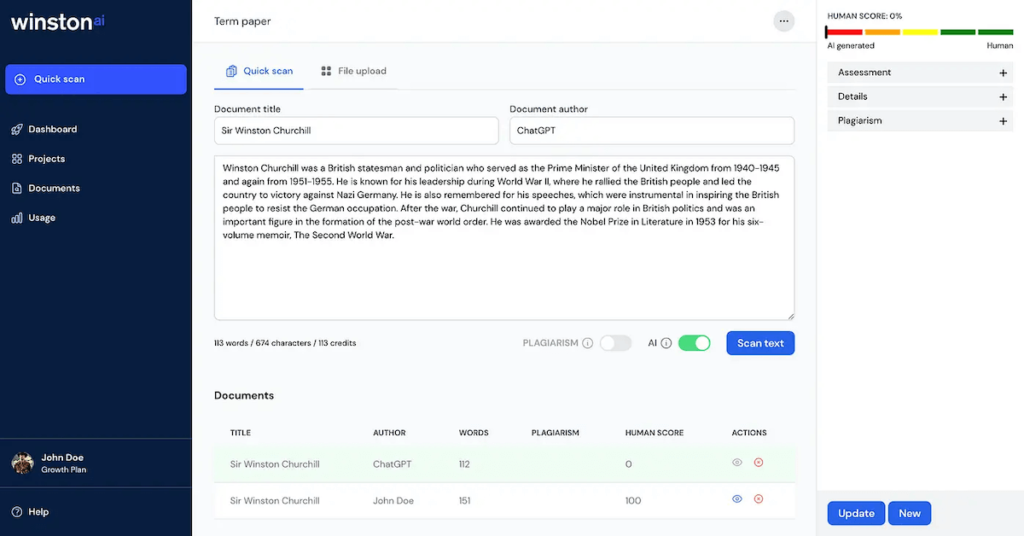
Winston AI-generated content checker is a good tool since its accuracy is the best in the market. In addition, the app also evaluates readability and functions as a plagiarism checker, which is another side benefit you can enjoy.
It is also a user-friendly solution that works perfectly fine with a stable Internet connection. You will most likely have no issues with its interface and tools.
But it does not work for free, unfortunately.
Winston’s help costs at least $18 monthly, and you will only have 80K words to scan. This payment will unlock only some of its capabilities, and you must spend at least $40 to enjoy all features. The free trial will not let you do much since you can only use the program for one week, or it will block its services after you scan 2K words.
2 — Originality AI 7.5/10 [REQUIRES PAYMENT]

This one is as good as the previous option since it also has anti-plagiarism and readability check features and can help you with academic studies. Nevertheless, it is the best AI detection program for marketers and business peopleю It focuses on site scans to prevent published content from being labeled as generated after algorithm updates.
It can still be useful for essay writing and to detect non-human writing when you search for references, sources, etc.
After testing it, I can say that this one is good and also quite affordable. But the info on its site is misleading while being 100% honest. You see, the price is $0.01/100 words, but this low price adds up to $20+ VERY FAST. I can only recommend it if you need such software only sometimes.
3 — Sapling 7.3/10 [FREE]
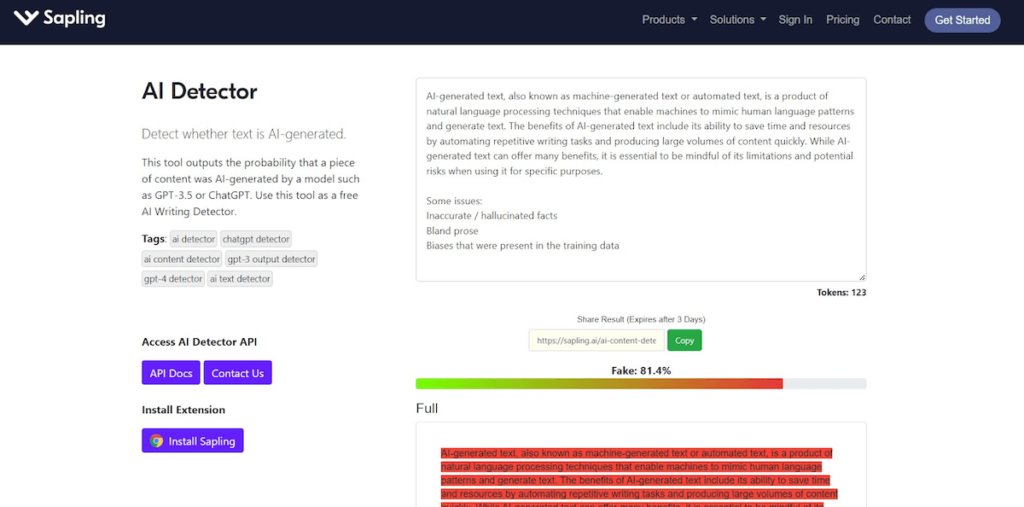
I love this tool. It costs zero dollars and zero cents, gives you rather accurate analysis results, and does its work best if you need to check if a paper was written by artificial intelligence. There is nothing stellar and game-changing to discuss regarding this app, but it embodies decency in the industry. Of course, it will not check your readability and grammar or whatever, but it is good for its only function.
Of 57 checks I’ve tested, Sapling missed only one generated text.
4 — GPT Zero 7.3/10 [FREE]
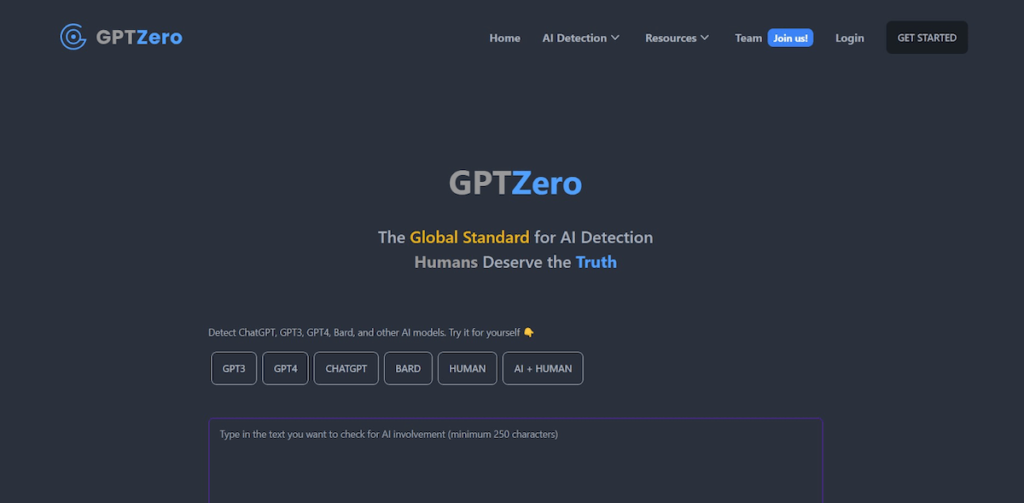
How to check if an essay is written by ChatGPT? This one is the official AI detector created by the company that has excited students with ChatGPT. And I must say several universities have been using it quite successfully.
The app is free, like Sapling. It can only help with ChatGPT AI detection but can also effectively analyze mixed texts written by robots and humans in tandem. Yet, the latter may give you inaccurate results. And, of course, it is most effective when you check GPT posts and not other texts, like from Jasper or Grammarly’s new non-human bot.
5 — Writefull 7/10 [FREE]
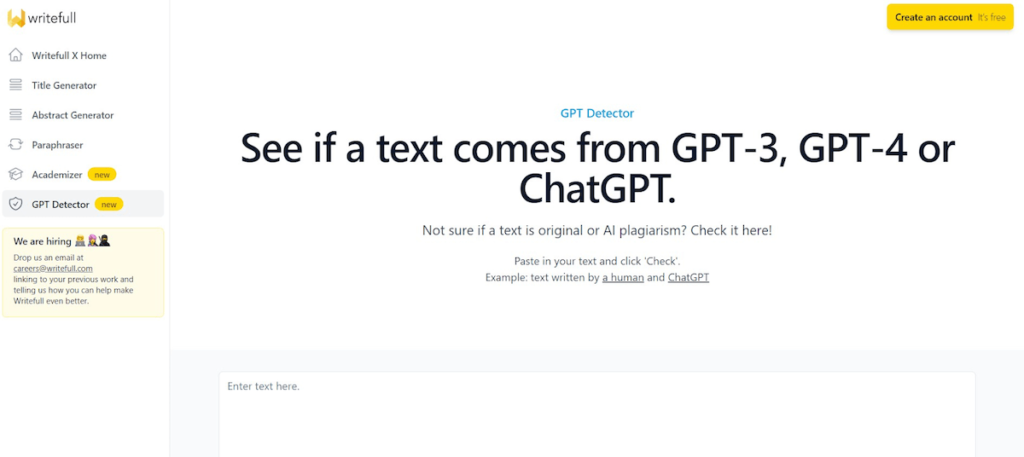
Just a good web-based app students can use. There is nothing too important to note besides that this website is secure and gives you more or less accurate results. I tested 45 ChatGPT’s texts, and the app made a mistake only twice when I added my content to the main creation by artificial intelligence.
How to Use AI Content Detectors for Academic Papers
While using artificial intelligence to write assignments is unfair, no one can stop you from doing this right away. Still, a person or a committee that evaluates your academic work will use an AI content checker to inspect if an essay is AI-generated. You must ensure that the software will not give a bad verdict for you.
You can also use it for
- Checking text quality: Programs like this can help you with clarity and readability.
- Getting content enhancement suggestions: Such applications can have rephrasing tools that make your writing sound much more persuasive, formal, and professional.
- Guaranteeing no reference in your papers leads to artificially created texts: That is rather embarrassing to unveil the fact that you referenced a generated piece. Your mentors will not appreciate research like this. Hence, it is best to detect non-human writing before relying on facts and claims from the Internet.
- Plagiarism, vocab, and grammar checks: The best AI detection solutions often have additional services and tools to help your text be better. Still, most of those legit AI detection tools are not free.
5 Tips for Effective Use of AI Content Detectors
Suppose you’ve found a legit, free/affordable AI detector for essays. Alright, what do you do with this app? Before checking your texts, here is what you must do:
- Analyze what this app can do for you: One AI writer detector can give you insights on clarity improvements and rewriting, checking your paper for copied content in parallel. Another option can only check if a text was written by AI, and that is it. Learn more about any app you want to use before conducting checks.
- Ensure a program can detect generated content created by not only GPT: How to check if an essay is written by AI if your checker only works with GPT materials?! Remember that specific software always has a design and a focus, and your chosen Chat GPT detector tool can give you inaccurate results when analyzing materials from another bot. For instance, some of the tested apps had inaccuracies with Grammarly’s artificial texts during the tests.
- Use two AI checker apps: Select two sites/applications with this feature and compare their results. If their reports are similar, you can rest assured programs work fine.
- Buy a subscription to a premium checker with your friends: You can save a lot by dividing the price between a small group. That way, you get access to all features and can ensure everyone guarantees the fairness of their academic results.
- Always combine the help of checkers with human proofreading: We still have the prerogatives machines have yet to or will never get. So, never neglect regular, reliable, traditional proofreading!
Final Words
Artificial intelligence innovation has already changed how academic history progresses, and it will continue to revolutionize educational (and not only educational) institutions. Please remember that such tools should only help you and not do your tasks for you. Stay diligent, do your best, and you will succeed! Best of luck, and may no AI paper detector accuse you of using bots to write essays!
Mike Russel
Latest Stories
Here’s what we've been up to recently.



